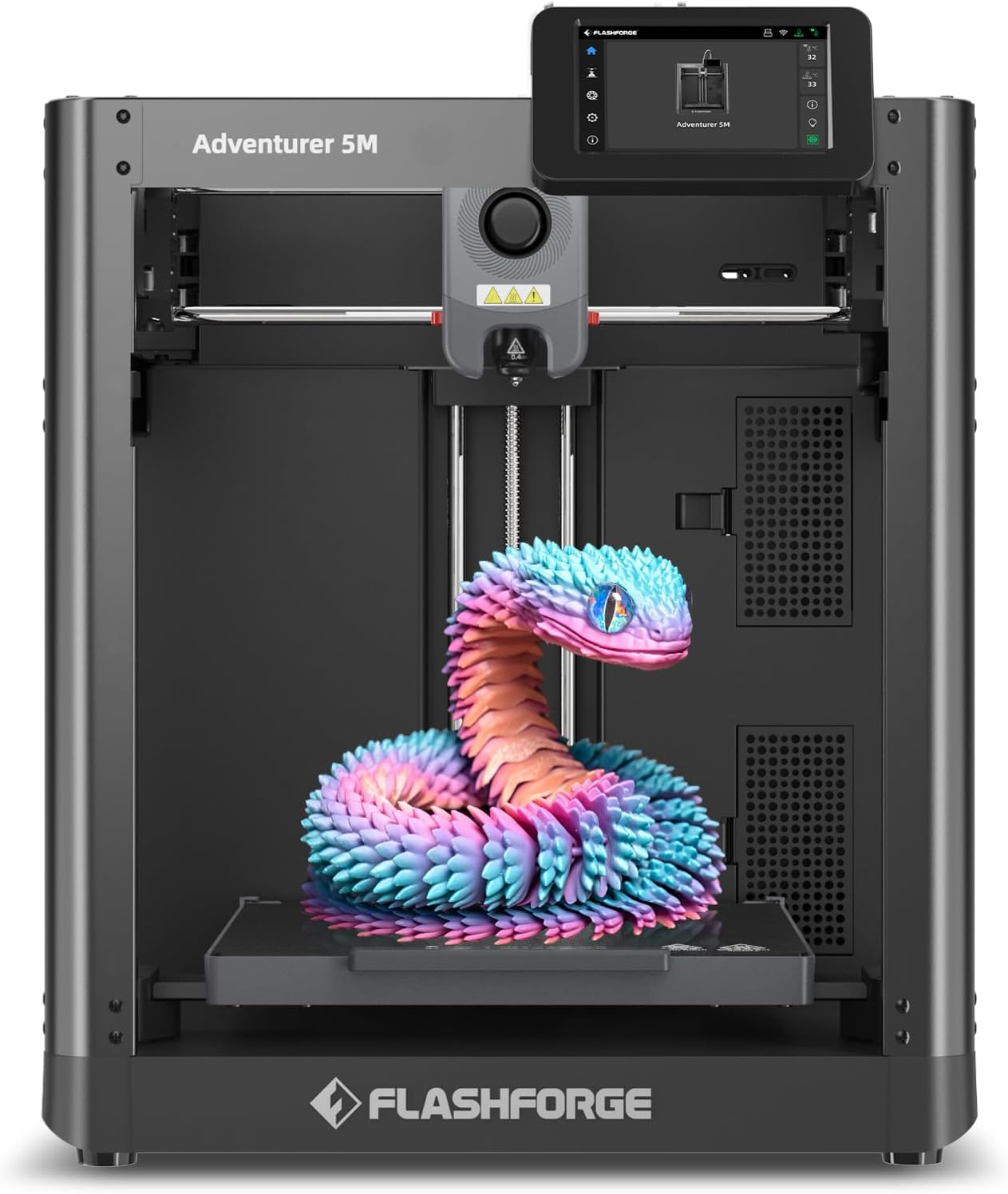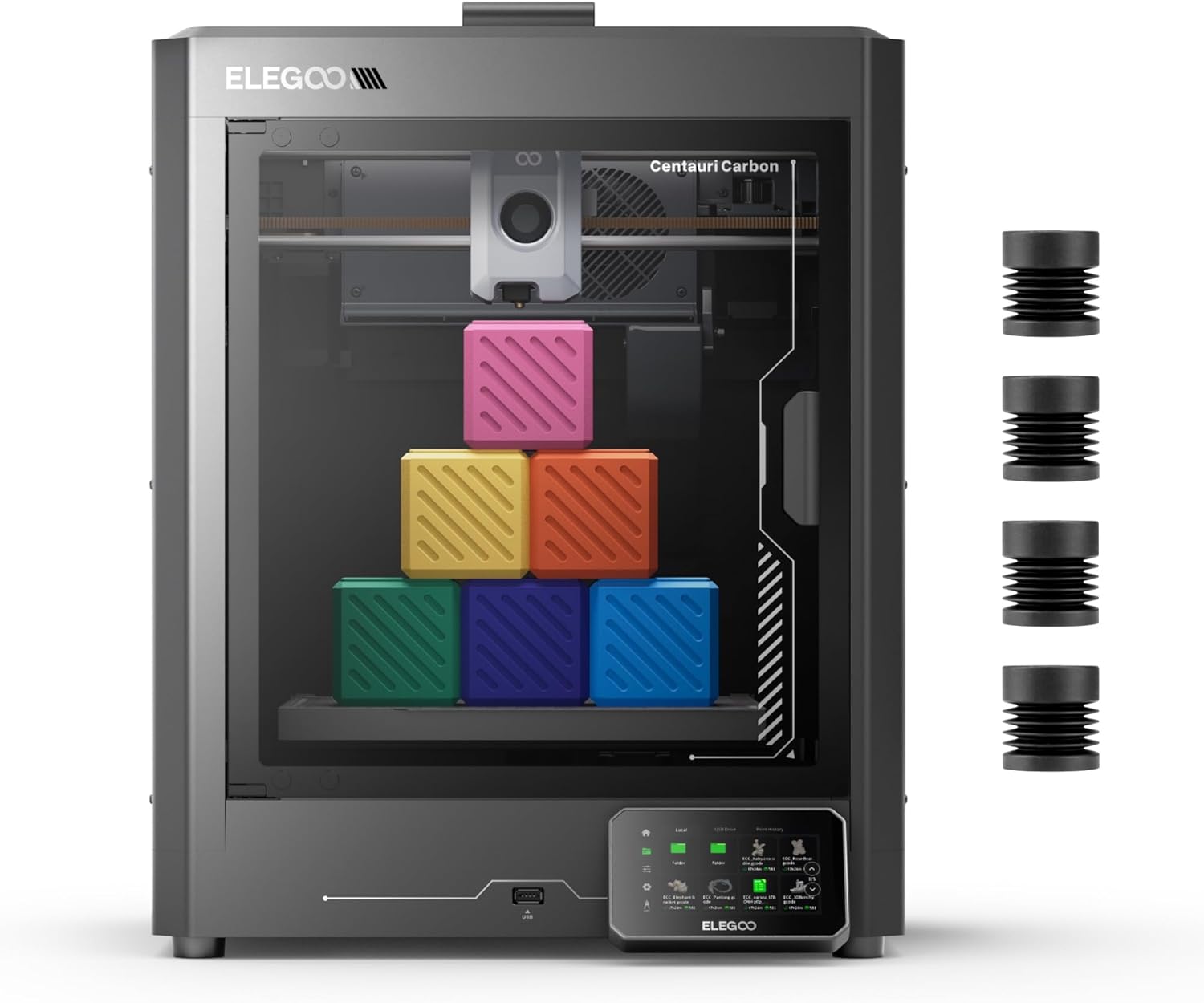I'm a participant in the Amazon Services LLC Associates Program, an affiliate advertising program designed to provide a means for me to earn fees by linking to Amazon.com and affiliated sites.
If you’re wondering Flashforge Adventurer 5M vs Elegoo Centauri Carbon, here’s the short take:
Go with the Adventurer 5M if you want a lower-cost, high-speed machine with ease of tinkering. Pick the Centauri Carbon if you want enclosure, thermal stability, and strong high-speed accuracy with more material flexibility.
Why it matters: your print quality, filament options, and long-term satisfaction depend heavily on features like enclosure, speed control, and stability.
📊 Flashforge Adventurer 5M vs Elegoo Centauri Carbon: Comparison Table
Feature | ||
|---|---|---|
Best For | Hobbyists, PLA prints, ease of access | Engineering materials, controlled environment |
Build Volume | 220 × 220 × 220 mm | 256 × 256 × 256 mm |
Max Nozzle Temp | 280 °C | 320 °C |
Max Bed Temp | 110 °C | 110 °C |
Enclosure | No | Yes, full enclosure with filter |
Frame / Structure | Open frame | Rigid, die-cast aluminum + sealed walls |
Max Speed / Accel | Up to 600 mm/s / 20,000 mm/s² (advertised) | Up to 500 mm/s / 20,000 mm/s² |
Accuracy / Stability Features | Basic precision, auto-leveling | Vibration compensation, pressure advance |
Filament Support | PLA, TPU, PETG, some composites | PLA, ABS, PETG, PC, composites |
Software / Autocalibration | FlashPrint + auto leveling | Full auto calibration, firmware features |
Weight & Size | Lighter, more open | Heavier, more rigid enclosure |
Price |
🧩 Elegoo Centauri Carbon vs Flashforge Adventurer 5M: Design & Usability
The Adventurer 5M comes with an open build space (i.e. no full enclosure) which makes changes, inspection, and manual adjustments easier. It features a 4.3-inch touch LCD interface, a quick-change nozzle system, and a flexible PEI print plate. Its build volume is 220 × 220 × 220 mm. The nozzle can reach 280 °C, and the bed can heat to 110 °C.
In contrast, the Elegoo Centauri Carbon is fully enclosed with a rigid chassis, glass front door, and CoreXY motion system to maintain structural stability. Its build area is 256 × 256 × 256 mm. The Centauri Carbon supports nozzle temperatures up to 320 °C and a heated bed up to 110 °C. It also includes an activated carbon filter for air purification within the enclosure. The printer comes mostly pre-assembled and runs full-auto calibration.
So the trade-off: Adventurer 5M gives you openness and easier user access; Centauri Carbon gives you controlled environment and more protection for high-temperature filament work.
⚙️ Flashforge vs Elegoo: Performance & Features
Speed & Motion
The Adventurer 5M advertises 600 mm/s travel speed and 20,000 mm/s² acceleration, with a nozzle flow spec of ~32 mm³/s. In practice, many users consider 300 mm/s an upper realistic print speed for retaining quality.
The Centauri Carbon is marketed for 500 mm/s speeds and 20,000 mm/s² acceleration in a stable, rigid CoreXY system. Its die-cast aluminum frame is intended to damp vibrations and maintain accuracy at higher speeds.
Material & Temperature Capabilities
With a 280 °C nozzle and 110 °C bed, the 5M can reliably handle PLA, PETG, TPU, and some composite blends. The exposed frame limits its consistency with high-temperature filaments like ABS or Nylon unless your environment is well controlled.
The Centauri Carbon, with a 320 °C nozzle and enclosed chamber, offers an edge for ABS, ASA, PC, carbon-fiber blends, and other engineering materials.The heated bed (110 °C) and partial chamber warming (reaching ~45 °C naturally) help reduce warping.
Accuracy, Stability & Extras
The Adventurer 5M lists positional precision of ~0.0125 mm (X/Y) and 0.0025 mm (Z) with ±0.2 mm on a 100 mm test cube. It has auto-leveling and quick-change nozzle support (0.25 / 0.4 / 0.6 / 0.8 mm).
The Centauri Carbon introduces vibration compensation, pressure advance, and resonance/ghosting mitigation to preserve print quality even at speed. Performance benchmarks show the Centauri Carbon producing low deviations in repeated prints (well under 0.1 mm) in tests conducted by 3D Printing Industry. In reviews, it’s praised for solid detail, minimal ringing, and strong repeatability. However, some early users report occasional nozzle/gear issues or menu glitches.
🧰 Elegoo vs Flashforge: Ease of Maintenance & Longevity
Because the Adventurer 5M is simpler (open frame, fewer sealed parts), it’s generally easier to access mechanical parts, swap nozzles, clean, or repair. Fewer enclosure seals or filters to deal with.
The Centauri Carbon has more moving pieces: chamber seals, filters, enclosed doors, more internal systems (vibration compensation, sensors). That increases complexity and possible points of failure. But its rigid frame helps reduce micro-movements and stress over time, which may improve longevity under heavy use.
Several users of the Centauri Carbon also appreciate that its extruder and gear systems are user-serviceable, though careful handling is needed due to tight tolerances. Some reviewers note firmware/menu features might need maturity.
✅ Pros & Cons
Flashforge Adventurer 5M
Pros
- Lower cost than many speed-focused enclosed machines
- Open access — easier to tinker, inspect, repair
- Good speeds for everyday filaments
- Quick-change nozzle system, auto-leveling
Cons
- No enclosure — less forgiving for ABS or engineering materials
- Stability and print quality drop at very high speeds
- Less ideal for filament types that warp
- Exposure to dust, drafts, and ambient changes
Elegoo Centauri Carbon
Pros
- Fully enclosed for thermal control and less warping
- Higher nozzle temp (320 °C) — support for more advanced materials
- Strong motion system with vibration compensation
- Excellent repeatability and detail at high speeds
- Auto calibration and more “out-of-the-box” usability
Cons
- More complicated internals and maintenance overhead
- Potential firmware/software quirks early on
- Enclosure adds complexity for access or modifications
- Heavier and less open to ad-hoc tweaking
Feature | ||
|---|---|---|
Best For | Hobbyists, PLA prints, ease of access | Engineering materials, controlled environment |
Build Volume | 220 × 220 × 220 mm | 256 × 256 × 256 mm |
Max Nozzle Temp | 280 °C | 320 °C |
Max Bed Temp | 110 °C | 110 °C |
Enclosure | No | Yes, full enclosure with filter |
Frame / Structure | Open frame | Rigid, die-cast aluminum + sealed walls |
Max Speed / Accel | Up to 600 mm/s / 20,000 mm/s² (advertised) | Up to 500 mm/s / 20,000 mm/s² |
Accuracy / Stability Features | Basic precision, auto-leveling | Vibration compensation, pressure advance |
Filament Support | PLA, TPU, PETG, some composites | PLA, ABS, PETG, PC, composites |
Software / Autocalibration | FlashPrint + auto leveling | Full auto calibration, firmware features |
Weight & Size | Lighter, more open | Heavier, more rigid enclosure |
Price |
🔍 Major Differences
- Enclosure vs Open Frame: The biggest practical difference. The Centauri Carbon’s enclosure gives it an advantage for warping-sensitive materials; the 5M’s openness gives you ease of access.
- Temperature Ceiling: 320 °C nozzle on Carbon vs 280 °C on 5M gives Carbon more flexibility for advanced filaments.
- Accuracy & Vibration Control: The Carbon’s motion system and vibration compensation help preserve quality at higher speeds, whereas 5M may start showing artifacts under stress.
- Ease of Service vs Complexity: 5M is easier to service; Carbon offers robustness but with more moving parts to maintain.
- Who Should Choose Which:
- Go Adventurer 5M if you mostly print PLA/TPU, want simpler maintenance, and prefer tinkering.
- Choose Centauri Carbon if you aim to print with ABS, PC, or composite materials, want more consistent results, and value thermal stability.
❓ FAQs
Can the Adventurer 5M handle ABS reliably?
It can, but with difficulty. Without enclosure, ABS tends to warp and delaminate in ambient drafts. The Centauri Carbon’s enclosure and higher nozzle temps make ABS printing more consistent.
Is the Centauri Carbon faster than the 5M in real prints?
Not always. While specs show higher speed capability, maintaining quality at top speeds depends on tuning, filament, and cooling. The Carbon’s stability helps it stay usable at higher speeds more reliably.
Which is easier to repair or modify?
The 5M is easier due to its open design and fewer internal protections. The Carbon gives you more performance, but at the cost of more parts and tighter tolerances.
Does the Centauri Carbon come ready to print?
Yes — it arrives mostly assembled, with automatic calibration routines.
Will the Centauri Carbon firmware evolve?
Likely yes. Some users already report early menu/firmware quirks, and Elegoo is expected to push updates.
Is the price difference justified?
If you plan to print advanced materials or need control over warp, the Centauri Carbon’s features are worth the premium. If your printing remains simple, the 5M gives excellent value.
🧭 Other Interesting Articles
- Canon MegaTank G3270 Setup: Step-by-Step Guide to Get Started Like a Pro
- Canon MegaTank vs Epson EcoTank: Ultimate SuperTank Showdown
- Canon MegaTank G3270 vs Canon PIXMA G6020: Choose the SuperTank That Truly Fits
- Canon MegaTank G3270 vs HP Smart Tank 5000: The Ink-Tank Face-Off
- Canon MegaTank G3270 vs Epson EcoTank ET-2800: No-Nonsense SuperTank Showdown
👨💻 About the Author
RegalPrinter is your definitive source for 3D printer comparisons, tech breakdowns, and user advice. We test gear from real use to separate specs from real-world value. Visit us at RegalPrinter.com for more deep dives.
Final Line (SEO reminder):
When comparing Flashforge Adventurer 5M vs Elegoo Centauri Carbon, your best choice depends on whether you prefer open flexibility (5M) or enclosed stability and high-temp capability (Centauri Carbon).


